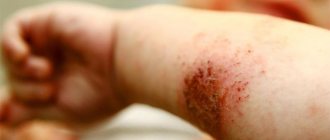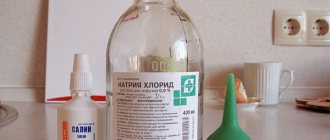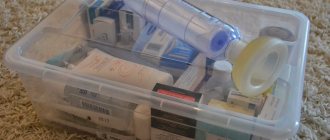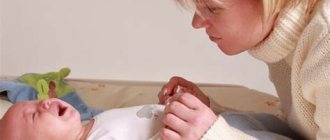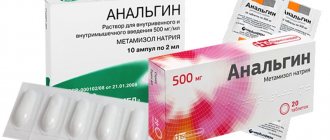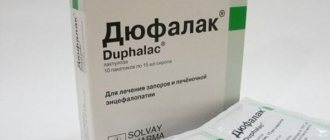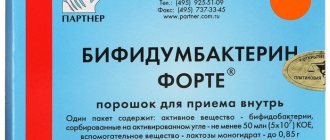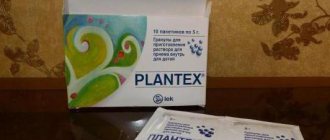Rinsing the nose with saline solution at home is a safe and useful procedure that helps to successfully treat a runny nose, fight allergies, and prevent the development of sinusitis at no extra cost. Doctors have known about the benefits of this manipulation for a long time and often advise their patients as an excellent prevention of vasomotor rhinitis during the cool season, with frequent colds and in situations where taking medications for some reason is undesirable: during pregnancy, nursing mothers, newborns.
What is saline solution - sodium chloride
Saline solution, or saline solution for short, is a simple saline solution. The salt content in the solution is 9 g/l. This concentration of salt is found in most human tissues, organs and blood. Saline solution, despite its name, does not contain all the substances necessary for the body, but is a liquid, as doctors say, isotonic to blood plasma.
For this reason, the use of this medicine is widespread:
- Dilution of drugs for injection;
- use as an antiseptic for treating wound surfaces, eyes, mucous membranes of the mouth, throat, nose;
- replenishment of the normal physiological level of fluid in the body in case of dehydration due to vomiting, diarrhea, poisoning;
- for inhalation with a nebulizer.
If we talk about using saline solution for rinsing the nose, its value is that it is well tolerated by the nasal mucosa (unlike ordinary water). When applied topically, there are no contraindications for use. The medicine is approved for expectant mothers, during breastfeeding, newborns, infants, allergy sufferers, and people with problems with internal organs. There are no restrictions on the time of use; the product can be used as many times as needed.
What is saline and how is it different?
According to doctors, saline is an aqueous solution of sodium chloride (salt) at a concentration of 0.9% . It is widely used in medicine not only as a drug for moisturizing the nose, but also as a means for hydrating the body (after severe vomiting, diarrhea, injuries, burns), and replenishing fluid in the body after operations.
Saline solution is used to dissolve medications that are administered by injection or intravenous infusion.
Saline solution for the nose is available in every pharmacy and medical supply stores. Saline solution is recommended primarily for dry mucous membranes (caused by allergies, rhinitis, harmful substances, tobacco smoke, being in a dry room), and also as a therapy for the treatment of respiratory diseases.
How to prepare saline solution at home
Sterile saline solution is sold in glass bottles of 250 and 400 ml, or in ampoules. The cost of such a product is low.
To rinse the nose, you can prepare the solution yourself. To make a saline solution for rinsing the nose, you should:
- Take 1 tsp. (9 g) salt.
- Dissolve it in 1 liter of water (boiled).
- Stir until the sediment dissolves or strain.
The solution prepared at home is not sterile and can only be used topically, for example, for rinsing the nose in adults and children over 3 years of age. The shelf life of homemade saline solution is one day. The temperature of the finished solution is 36C.
Is it possible to rinse a child’s nose with saline solution?
This method is recognized by otolaryngologists as unique in its simplicity, accessibility and effectiveness. With one simple rinse with saline, you can quickly remove nasal secretions and maintain the natural moisture of the nasal mucosa. This helps stop a runny nose and prevents the development of complications.
Is it possible to rinse a child’s nose with saline solution prepared by yourself? Quite. The main thing is to maintain the required concentration: one teaspoon per liter of boiled water. This water should taste a little salty. If you make the concentration lower, it will cause an unpleasant irritating sensation during rinsing. If it is more, then such a solution will dry out the mucous membrane too much, and possibly damage its cells.
Inhalation with saline solution for catarrh
Qatar is a runny nose in the form of an excessive amount of nasal discharge, most often in a watery form. It makes breathing difficult, and its development is associated with inflammation of the nasal mucosa.
May have an allergic basis. Associated symptoms are nasal congestion, redness, itching or burning of the mucous membrane, sneezing, and watery eyes.
One of the home treatments for catarrh is the use of saline solution. In case of mild catarrh, treatment can begin with saline solution in the form of inhalations.
Inhalations with saline solution are recommended for people suffering from acute and chronic diseases of the respiratory system. Due to inhalation, the saline solution enters directly into the respiratory tract , due to which it quickly moisturizes and cleanses the affected areas of the respiratory tract.
The saline solution should be administered using a nebulizer. This is a special device that allows you to produce an aerosol, i.e. a fine-droplet suspension from the supplied drug (in this case, saline solution). Such a device consists of a container into which a saline solution or other substance is poured, a pneumatic compressor, a sprayer and a nozzle.
The inhaler can be purchased at any pharmacy. It should be kept in mind that before and after inhalation, you should thoroughly wash each of the plastic parts of the atomizer, thereby preventing the spread of possible pathogenic microorganisms.
How to rinse your nose with saline solution
There are several interesting ways to properly rinse your nose with saline as an adult:
- The simplest, but not the safest way. The liquid is poured into the palm of one hand. Next, we close the upper nostril with our finger, and try to strongly draw in the salt solution from the palm of the lower nostril so that the water flows freely through the nose and mouth. Don't close your mouth. Cleaning is carried out until the water is clean, without signs of mucus and dirt. The unsafety of this method is that by sucking in the solution through the nose, a person can contribute to the transfer of microbial contents from the mucous membrane into the paranasal sinuses or into the middle ear and, if hygiene rules are not followed, cause otitis media.
- Using a kettle. Interesting devices have been created for this procedure - a neti pot or a neti kettle, but an ordinary teapot will also work. Saline solution is poured into it, the head is tilted over the bathtub, the spout of the kettle is inserted into the nasal passage and the nasal cavity begins to be washed by gravity. The principle is the same: until clean water appears.
- With a syringe. How to rinse the nose with saline solution for an adult with a syringe? Fill the syringe with saline solution and discard the unnecessary needle. The contents should be introduced slowly and under slight pressure. Cleansing is carried out until the water flowing from the nose becomes clear.
Instructions for rinsing the nose
Many young mothers are afraid to wash their child's nose. They can be understood. Such a baby is lying there and still can’t even lift her head on her own. This means you should be very careful, but you shouldn’t be scared either. There are several stages:
We recommend reading: Aquamaris drops for newborns
- To rinse a newborn's nose, in addition to saline solution, you will need a pipette, a syringe, a bulb and cotton swabs.
- Next, the baby needs to clean the nasal passages, for which, using a rubber bulb, all the mucus that has accumulated there is pulled out. Such an instrument can also be replaced with a special tube with a rubber tip, one end of which is inserted into the child’s nose, and with the other the mother draws in air.
- A syringe without a needle is filled with saline solution (up to 5 ml). The child's position is lying on his side. The product is injected into the nose, but with a small pressure, until the mark on the syringe reaches 2.5. Then the baby is placed on the other side and a similar procedure is carried out to rinse the other nostril.
- After administering the medicine, the remaining mucus and solution are drawn out using an aspirator bulb. Use cotton swabs to completely clean the nasal cavity. Such a flagellum is inserted to a depth of no more than 2 cm. From a hygiene point of view, a new tampon should be used for each nostril.
- If the procedure was carried out for the purpose of prevention, then no further action will be needed. But when the baby has a runny nose, after cleaning, you should also drip some medicine. And here it’s worth choosing the right one, because not every product is suitable for a child under one year of age. Therefore, consultation with a pediatrician in this case is mandatory.
Flushing must be supervised, as the baby may simply choke. If this happens, then he is laid on his stomach and lightly tapped between the shoulder blades. It is also important for parents to know that under no circumstances should the newborn’s head be tilted back, otherwise fluid may pour into the Eustachian tube, and this can lead to acute otitis media. For the same reason, the medicine is administered with low pressure.
This rinsing with saline solution can be supplemented with herbal infusions of chamomile, calendula or sage. These plants will have a preventive effect on mucous surfaces, especially with regard to inflammation. It is not necessary to use infusions every day. They can be included in the autumn and spring periods, when there is an exacerbation in allergies. Thus, for children under one year old this will be additional protection.
How to rinse a baby's nose with saline solution
For newborn children, it is more profitable to buy a nasal spray or sterile saline solution to clean their noses. If you need to make a solution at home, weigh all the ingredients on an electronic kitchen scale. The optimal salt content per 1 liter of water is 9 g.
Devices designed for adults (for example, a kettle) are not suitable for this. We need soft, gentle and non-traumatic methods. Therefore, saline solution is simply dropped into the spout from a pipette. Newborns - one or two drops into the nasal passage, from one year old - 3-5 drops. The procedure is carried out lying on the back with the head turned to one side or on the side. Softened crusts and dirt are removed from the spout with cotton swabs or swabs. If there is a lot of mucus and the child’s age allows, it is more convenient to use a nasal aspirator.
Correct execution of the procedure
If the newborn is already holding his head up on his own, then the sinuses are washed when he is in an upright position. In this case, you need to slightly tilt your head forward. This will protect your baby from getting water in his ears.
Before starting the procedure, prepare a rubber syringe, cotton swabs, a syringe without a needle, twisted cotton wool and a pipette.
After this, turn the baby on its side and, using gentle movements with a twisted flagellum or a cotton swab, remove dried crusts from its nose.
Take a syringe and use it to suck out the mucus.
For children under one year of age, saline solution is indicated only in the form of drops.
Pipette the saline solution. Make sure it is at room temperature. Place one or two drops into each nostril.
Read: How to stop breastfeeding
Turn the child over to the other side and slowly squirt saline into the other nasal passage. In this case, the baby's mouth should be slightly open. It may happen that the baby swallows the instilled saline solution, starts coughing and the liquid flows out of his mouth. In this case, simply turn him over on his tummy and lightly pat him on the back.
Use a syringe to suck out excess liquid, mucus and remaining crusts.
At the final stage, drop drops (Tocopherol acetate or sea buckthorn oil) into each nasal passage of the baby. This will help ease your baby's breathing.
How to properly rinse a child's nose with saline solution
The reaction of children to such a procedure is most often negative, which children's doctors honestly warn parents about. Children do not like this kind of interference. Therefore, a lot of effort will have to be made to ensure that the manipulation is effective. The temperature of the saline solution for the procedure for a child should be slightly warmer than room temperature. It is better for kids to use a syringe or pipette for this; schoolchildren can use a kettle. In all cases, nasal cleansing is carried out over a bathtub or sink. You cannot quickly pour the solution; the entire manipulation should be done slowly so as not to cause injury to the baby and to make the actions performed comfortable.
How to safely rinse a small child's nose with saline?
There are no special precautions for this procedure. Saline solution is a safe product and cannot harm. You just need to be careful when performing the procedures themselves.
- Carefully bury the nose with a pipette, bulb or syringe so as not to injure the baby.
- It is imperative to hold the child's head so that he does not throw it back, because... this leads to choking and choking.
If the procedure is performed according to all the rules, then there can be no negative consequences.
Rinsing the nose with saline solution for a runny nose
When rinsed, saline solution quickly stops a runny nose and significantly reduces the need for other medications, such as antibiotics. A timely and regular procedure for treating the nose with saline reduces swelling and frees the nose from excess secretions.
Rinsing the nose with saline solution for sinusitis
In case of sinusitis, saline solution is used to wash out pus from the sinuses, which prevents further spread of the infection. Cleansing sessions are carried out every one and a half or two hours. It is useful to alternate rinsing with saline solution with similar procedures with herbal formulations and the use of antibacterial drugs and antibiotics. It is important to remember that in order to cure sinusitis outside the hospital, saline solution is used as an additional technique aimed at preventing the stagnation of pus in the maxillary sinuses, and not as an independent treatment.
Who and when should use saline sodium chloride solution to rinse the nose?
Saline solution is an antiviral, antiseptic, mucolytic, moisturizing agent. Thus, when washing, the following therapeutic effects occur:
- thinning and removing excess mucus from the nasal passages;
- removal of pathogenic bacteria, viruses, allergens;
- relieving inflammation in the nasopharynx;
- moisturizing mucous membranes;
- normalization of microflora in the nasal cavity.
The procedure of rinsing the nose with saline solution, or irrigation, can be performed by absolutely anyone: an adult, a child, an elderly person, a pregnant woman. This product is absolutely safe and non-addictive.
The solution dilutes the viscous secretion (snot) and removes it from the nasal cavity. Such washing is recommended as daily hygiene, as well as for the prevention and treatment of diseases in the nasopharynx.
During influenza epidemics and seasonal allergic rhinitis
To avoid contracting a viral or bacterial infection that enters the body through the nose, it is advisable to rinse your nose with saline every time you are in crowded places. For a child - after visiting kindergarten or school, for an adult - after work. In this case, the infection, if it gets on the mucous membrane, is mechanically removed from the nose, without having time to spread throughout the body.
In a similar way, rinsing the nose with saline works for a runny nose caused by various allergic substances. The procedure allows you to wash away allergens that have entered the nasal mucosa, relieve swelling and make breathing easier.
For various inflammations of the ENT organs
To stop the development of inflammation in the nasal sinuses (sinusitis and sinusitis) and prevent the disease from becoming chronic, it is important to rinse the nose from mucus and, possibly, pus.
Inflammation of the middle ear (otitis) is often accompanied by a runny nose and swelling of the nasal mucosa. Irrigation helps get rid of excess mucus, and the effectiveness of using nasal drops after this becomes maximum.
In cases of inflammation of the throat (tonsillitis, pharyngitis, laryngitis), a special method of rinsing the nose with saline is used, when the liquid, passing through the nasopharynx, flows out of the mouth.
To cleanse and moisturize the nasal mucosa
People who have to breathe polluted air with dusty substances need to hygienically rinse their nasal passages daily.
Saline solution of sodium chloride will help moisturize the nasal mucosa in conditions of increased dry air.
Washing helps restore strength in case of severe fatigue and depression, relieves headaches, insomnia, diseases of the bronchi and lungs.
If you rinse your nose as a daily procedure, it will bring great health benefits.
What else can you rinse your nose with, besides saline solution?
Pharmacy preparations for nasal rinsing
Nowadays, pharmacists have developed many natural products for caring for the nasal cavity. These are nasal sprays and drops based on sea water from the Aqualor, Aqua Maris, Otrivin Sea, Humer series, Morenazal, Quix, Dolphin and others. They contain natural purified water from seas or oceans in optimal concentration. The design of these products allows you to accurately dose the saline solution, and various attachments and accessories make their use convenient for children from birth. The only disadvantage of such drugs is the high cost and small volume.
Infusions and decoctions of medicinal herbs
In addition to saline solution, the nose is washed with decoctions and herbal infusions. To prepare the infusion, you need to pour a tablespoon of herbs or collection into a glass and pour boiling water over it. After this, cover the glass with a lid and let stand for 30 minutes. After cooling, the herbal infusion is ready for rinsing. Among the medicinal herbs, herbs with an aseptic effect are suitable:
- Pharmaceutical camomile;
- eucalyptus leaves;
- sage;
- calendula flowers.
Antimicrobial nasal rinses
The indication for rinsing with antimicrobial agents is the presence of a pronounced purulent process in the nasal cavity and sinuses. In all other cases, wash with clean saline solution.
Among the antimicrobial rinsing agents, the following are worth mentioning:
- Furacilin. An affordable and popular remedy for topical use. It is also acceptable for cleansing and hygiene of the nasopharynx. It is available in the form of an aqueous pharmaceutical solution and in tablet format, which must be crushed and diluted in warm water. You cannot use a topical alcohol solution of furatsilin, as this can lead to extensive swelling.
- Dioxidine. This synthetic antibacterial drug is prescribed for treating the nasal cavity for bacterial inflammation and sinusitis. A ready-made 1% solution is sold in pharmacy chains. This product can cause a serious allergic reaction; before use, be sure to conduct an allergy test to determine tolerance. The maximum permissible dose of the drug for intracavitary use is 70 ml per day, that is, 35 ml in each nasal passage.
- Miramistin. Antiseptic with a very wide spectrum of effects. In the nasal cavity it is capable of destroying almost all types of bacteria, fungi and viruses. Doctors recommend the use of this remedy for treating the inner cavity of the nose for all types of runny nose and to get rid of sinusitis. Available in the form of a 0.01% solution for topical use.
- Chlorhexidine. Safe drug with aseptic action. It is used for irrigation of mucous membranes and is a 0.05% solution. Safety equal to sodium chloride solution.
Antimicrobial agents are similar in action to saline solution, but their choice should be discussed with a specialist, taking into account the specifics of their use.
Saline solution for the nose of infants and children
Saline is a very good nasal cleaner for babies and young children. A runny nose in newborns causes problems with normal breathing, which makes it much more difficult for the baby to breastfeed, bottle-feed, or sleep, and may cause the baby to cry.
To clear the airways of infants, you need to purchase an aqueous solution of sodium chloride at a concentration of 0.9% , which is available in the form of small ampoules with a volume of 2 to 10 ml .
Cleaning the nose in newborns and children should be done by instilling a few drops of saline into each nasal passage ( 1-2 drops are often sufficient ).
Injecting saline into the nose should make it easier to clear the residue. Cleaning your nose can be done daily after an evening swim.
When not to rinse your nose
Saline solution for rinsing the nose at home is a local ENT procedure; it does not affect the general condition of the body and has no contraindications for use.
A solution of sodium chloride salt as a hygienic procedure during rhinitis can be used 2-3 times a day. You should not rely on the effectiveness of saline solution as an independent treatment. In complex and advanced cases, you should seek help from an otolaryngologist.
As a preventive measure, people predisposed to respiratory diseases may be recommended to wash them daily during seasonal exacerbations.
The studio provides practical advice for proper nasal rinsing.

